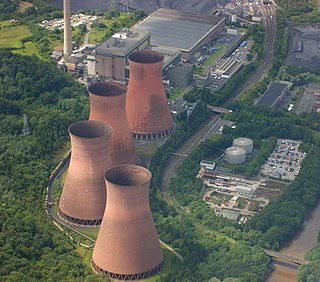
Walsum power plant is a coal-fired power station owned by Evonik Industries. It is in the Walsum quarter of Duisburg, on the area of the former Walsum coal mine.

Walsum power plant is a coal-fired power station owned by Evonik Industries. It is in the Walsum quarter of Duisburg, on the area of the former Walsum coal mine.
It has an installed output capacity of 600 megawatts (MW). The chimney is 300 metres high, one of the highest chimneys in Germany. The power station supplies not only electricity but also process steam for the Norske Skog paper factory as well as long-distance heating and electricity to Fernwärmeschiene Niederrhein and the Walsum coal mine. From approximately 930,000 tons of coal, the power station produces approximately 2.2 billion a kWh electricity, 33 million a kWh of long-distance heating, 500,000 t process steam and 250 million m³ compressed air per year. It has a coal storage capacity of 34.000 t.
At the Duisburg Walsum location, a power plant was established in 1928 to meet the steam needs of the Walsum coal mine. In 1957, the plant was expanded with a power station block (Block 6) with 68 MW. In 1959 and 1960, two additional power station blocks (Blocks 7 and 8) with 150 MW each were added. In 1988, Block 9, with an output of 410 MW, replaced Blocks 6 and 8. Construction of Block 10, with a capacity of 700 MW, began in 2007. Block 10 was scheduled to be operational by the end of 2013 after resolving serious issues with the high-tech steel of the boiler. On June 30, 2007, the Walsum coal mine ceased operations.

NLC India Limited (NLC) is a central public sector undertaking under the administrative control of the Ministry of Coal, Government of India. It annually produces about 30 million tonnes of lignite from opencast mines at Neyveli in the state of Tamil Nadu in southern India and at Barsingsar in Bikaner district of Rajasthan state. The lignite is used at pithead thermal power stations of 3640 MW installed capacity to produce electricity. Its joint venture has a 1000 MW thermal power station using coal. Lately, it has diversified into renewable energy production and installed 1404 MW solar power plant to produce electricity from photovoltaic (PV) cells and 51 MW electricity from windmills.

The Bełchatów Power Station is a coal-fired power station near Bełchatów, Poland. It is the largest thermal power station in Europe. The power station is owned and operated by PGE GiEK Oddział Elektrownia Bełchatów, a subsidiary of Polska Grupa Energetyczna.

The Ironbridge power stations refers to a series of two power stations that occupied a site on the banks of the River Severn at Buildwas in Shropshire, England. The Ironbridge B Power Station was operated by E.ON UK but the site is now owned by Haworth Group. The station stands near the Ironbridge Gorge World Heritage Site. Originally powered by coal, they were converted to use 100% biomass fuel. Ironbridge B Power Station stopped generating electricity on 20 November 2015, with the decommissioning process continuing into 2017. The main phase of the 27-month demolition process began at 11:00 GMT on 6 December 2019, commencing with the four cooling towers.

Rye House Power Station is a 715 MW combined cycle gas turbine (CCGT) power station located near Rye House railway station in Hoddesdon, Hertfordshire.

Scholven Power Station is a coal-fired power plant in Gelsenkirchen, Germany. With an installed capacity of 2,126 megawatts, it is one of the largest power stations in Europe. It is owned by Uniper.

Herne power plant is a coal-fired power plant located at Herne in North Rhine-Westphalia, Germany. It was constructed in 1962. The installed capacity of the plant is 950 megawatts. The power plant is owned and operated by Evonik Steag GmbH, a subsidiary of Evonik Industries.
Atikokan Generating Station is a biomass power plant owned by Ontario Power Generation (OPG) located 8 km (5 mi) north of Atikokan, Ontario. The plant employs 90 people. The Atikokan Generating Station began operation as a coal fired station in 1985 and underwent an overhaul in the autumn of 2003.

The Littlebrook Power Station were a series of four oil and coal-fired power stations situated on the south bank of the River Thames, next to the Queen Elizabeth 2 Bridge and the Dartford Tunnel in Dartford, Kent. The final power station, Littlebrook D, ceased operating in March 2015, and has now been demolished.

Great Yarmouth Power Station is combined cycle gas turbine power station on South Denes Road in Great Yarmouth in Norfolk, England, with a maximum output of 420 MW electricity, opened in 2001. It is built on the site of an oil-fired power station, built in 1958 and closed and demolished in the 1990s. A coal-fired power station was built in Great Yarmouth in 1894 and operated until 1961. The station is operated by RWE.

The Tilbury power stations were two thermal power stations on the north bank of the River Thames at Tilbury in Essex. The 360 MW dual coal- and oil-fired Tilbury A Power Station operated from 1956 until 1981 when it was mothballed, prior to demolition in 1999. The 1,428 MW Tilbury B Power Station operated between 1968 and 2013 and was fueled by coal, as well as co-firing with oil and, from 2011, biomass. Tilbury B was demolished in 2016–19. Since 2013 three other power stations have been proposed or constructed in Tilbury.
Carrington Power Station is a combined cycle gas turbine power station, which was completed in Autumn 2016 and began commercial operation on 18 September 2016. It is located on the site of a former coal-fired power station, close to the villages of Carrington and Partington in the Greater Manchester Area and 12 km (7.5 mi) southwest of Manchester City Centre. The Manchester Ship Canal and the River Mersey run alongside the site, in Trafford, Greater Manchester, in North West England.
Birchills power station and Walsall power station are a series of three coal-fired power stations in, or near, Walsall in the West Midlands, England.

Ince Power Station refers to two demolished power stations near Ellesmere Port in Cheshire, North West England.

Darlington power station refers to a series of two coal-fired power stations situated in Darlington in County Durham, North East England.

Kirkstall Power Station was a coal-fired unit opened in 1930, serving the city of Leeds, West Yorkshire, England.
South Africa has a large energy sector, being the third-largest economy in Africa. The country consumed 227 TWh of electricity in 2018. The vast majority of South Africa's electricity was produced from coal, with the fuel responsible for 88% of production in 2017. South Africa is the 7th largest coal producer in the world. As of July 2018, South Africa had a coal power generation capacity of 39 gigawatts (GW). South Africa is the world's 14th largest emitter of greenhouse gases. South Africa is planning to shift away from coal in the electricity sector and the country produces the most solar and wind energy by terawatt-hours in Africa. The country aims to decommission 34 GW of coal-fired power capacity by 2050. It also aims to build at least 20 GW of renewable power generation capacity by 2030. South Africa aims to generate 77,834 megawatts (MW) of electricity by 2030, with new capacity coming significantly from renewable sources to meet emission reduction targets. Through its goals stated in the Integrated Resource Plan, it announced the Renewable Energy Independent Power Producer Procurement Programme, which aims to increase renewable power generation through private sector investment.

Poole Power Station was a coal-fired power station located in Hamworthy, Poole, in Dorset. Its 325 ft tall twin chimneys were prominent landmarks and it was the tallest building in Dorset until its partial demolition in 1993.
Watford Power Station was a coal-fired power station situated in Watford's Riverside area. The station was built by the Watford Corporation Electricity Department starting with the installation of cables in 1899 with completion around 1900, near the banks of the River Colne. A gas turbine power station was commissioned in 1980.
Ribble Power Station was a coal-fired electricity generating station on the River Ribble in Penwortham near Preston, Lancashire, England. The station was built by the Corporation of Preston to replace a small privately-run generating station in the town. It supplied electricity to Preston and the surrounding area from 1923 until 1976. The station was expanded with new equipment in 1943–47 which remained in operation until the power station was closed in 1976 and was subsequently demolished.
Bromborough power stations are three electricity generating stations that supplied power to industrial and domestic users in Bromborough, Port Sunlight and the wider Wirral area from 1918 until 1998. Bromborough power station provided public electricity supplies from 1951 to 1980. Central power station Bromborough (1918–1998) was originally owned by Lever Brothers and supplied electricity to domestic users in Port Sunlight as well as electricity and steam to industrial users. Merseyside power station Bromborough (1958–1998) was also owned by Unilever and provided electricity and steam at a range of pressures to industrial users in the locality. All three power stations at Bromborough have been demolished.